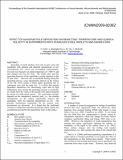| dc.contributor.author | Buongiorno, Jacopo | |
| dc.contributor.author | McKrell, Thomas J. | |
| dc.contributor.author | Hu, Lin-Wen | |
| dc.contributor.author | Kim, Hyungdae | |
| dc.date.accessioned | 2011-02-11T21:08:27Z | |
| dc.date.available | 2011-02-11T21:08:27Z | |
| dc.date.issued | 2009-06 | |
| dc.identifier.other | ICNMM2009-82082 | |
| dc.identifier.uri | http://hdl.handle.net/1721.1/60933 | |
| dc.description.abstract | Quenching of small stainless steel rods in pure water and
nanofluids with alumina and diamond nanoparticles at low
concentrations (0.1 vol%) was investigated experimentally.
The rods were heated to an initial temperature of ~1000 °C and
then plunged into the test fluid. The results show that the
quenching behavior of the nanofluids is nearly identical to that
of pure water. However, due to nanofluids boiling during the
quenching process, some nanoparticles deposit on the surface
of the rod, which results in much higher quenching rate in
subsequent tests with the same rod. It is likely that particle
deposition destabilizes the film-boiling vapor film at high
temperature, thus causing the quenching process to accelerate,
as evident from the values of the quench front speed measured
by means of a high-speed camera. The acceleration strongly
depends on the nanoparticle material used, i.e., the alumina
nanoparticles on the surface significantly improve the
quenching, while the diamond nanoparticles do not. The
possible mechanisms responsible for the quench front
acceleration are discussed. It is found that the traditional
concept of conduction-controlled quenching cannot explain the
acceleration provided by the nanoparticle layer on the surface. | en_US |
| dc.description.sponsorship | Korean Research Foundation (Korean Government (MOEHRD) (KRF- 2007-357-D00026)) | en_US |
| dc.description.sponsorship | AREVA | en_US |
| dc.description.sponsorship | Douglas C. Spreng | en_US |
| dc.language.iso | en_US | |
| dc.publisher | American Society of Mechanical Engineers | en_US |
| dc.relation.isversionof | http://dx.doi.org/10.1115/ICNMM2009-82082 | |
| dc.rights | Article is made available in accordance with the publisher's policy and may be subject to US copyright law. Please refer to the publisher's site for terms of use. | en_US |
| dc.source | J. Buongiorno via Chris Sherratt | en_US |
| dc.title | Effect of nanoparticle deposition on rewetting temperature and quench velocity in experiments with stainless steel rodlets and nanofluids | en_US |
| dc.type | Article | en_US |
| dc.identifier.citation | Kim, H., et al. "Effect of nanoparticle deposition on rewetting temperature and quench velocity in experiments with stainless steel rodlets and nanofluids." Proceedings of the ASME 2009 7th International Conference on Nanochannels, Microchannels and Minichannels, ICNMM2009, June 22-24, 2009, Pohang, South Korea. | en_US |
| dc.contributor.department | Massachusetts Institute of Technology. Department of Nuclear Science and Engineering | en_US |
| dc.contributor.department | MIT Nuclear Reactor Laboratory | en_US |
| dc.contributor.approver | Buongiorno, Jacopo | |
| dc.contributor.mitauthor | Buongiorno, Jacopo | |
| dc.contributor.mitauthor | Kim, Hyungdae | |
| dc.contributor.mitauthor | McKrell, Thomas J. | |
| dc.contributor.mitauthor | Hu, Lin-Wen | |
| dc.relation.journal | Proceedings of the ASME 2009 7th International Conference on Nanochannels, Microchannels and Minichannels, ICNMM2009 | en_US |
| dc.eprint.version | Final published version | en_US |
| dc.type.uri | http://purl.org/eprint/type/ConferencePaper | en_US |
| eprint.status | http://purl.org/eprint/status/PeerReviewed | en_US |
| dspace.orderedauthors | Kim, H; Buongiorno, J.; Hu, L. W.; McKrell, T. | |
| mit.license | PUBLISHER_POLICY | en_US |
| mit.metadata.status | Complete | |
